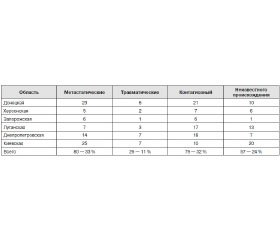Международный неврологический журнал 5 (75) 2015
Вернуться к номеру
Еtiologic and pathogenetic features of brain abscesses
Авторы: Yasharov Yu.A., Tsymbaliuk V.I., Tkachyk I.P., Tsymbaliuk Yu.V.
SI "Institute of Neurosurgery named after A.P. Romodanov of NAMS of Ukraine" Kyiv, Ukraine
Рубрики: Неврология
Разделы: Клинические исследования
Версия для печати
Research purpose: to study of etiological and pathogenetic features of brain abscesses based on clinical data and the results of bacteriological tests on their own clinical experience.
Introduction: Significant advances in the diagnosis and management of brain abscess over the past several decades have improved the expected out of disease once regarded as invariable fatal. Despite this, brain abscess continues to present a serious and potentially life-threatening condition. Intracranial abscess formation is a direct interaction between the virulence of the microorganism and the immune response of the patient. There are several main types of brain abscesses: metastatic - the transfer of infection by hematogenous from primary focus of infection, contiguous - that arise from the focus "in the neighborhood" as a result of head trauma or surgical procedure. Frequent abscesses in which the focus of infection cannot be identified.
Process of brain abscess maturation takes at least two weeks, usage of steroids may delay it.
When brain abscesses have not pathognomonic signs, symptoms of this disease are variable and nonspecific.
CT and MRI depends on the stage of disease: early and late cerebritis, early and late stage of the capsule.
There is no one best way to treat brain abscess. Treatment of brain abscess usually requires a multimodal approach, including medical and surgical treatment modes. Brain abscess is the most challenging goal to antibiotics due to the presence of the blood-brain barrier and capsules.
Methods and subjects: 242 cases of brain abscess were analyzed for patients from 6 areas of Ukraine. The patients' age from 1 month to 74 years, the average age of the patients was (36,5 ± 13,8) years.
All patients are subject to clinical and instrumental studies includes an analysis of anamnesis data, neurological examination, general clinical blood tests, otoneurologist inspection and neuro-ophthalmological evaluation. All patients were performed CT or MRI.
Also, all patients were inspected with the help of cultural testing (bacterial seeding).
Results and discussions: Among all analyzed cases, the abscess was solitary at 190 (78.5%) patients, multicompartment abscess - 22 (9.1%) patients and 30 (12.4%) patients have multiple abscess.
In more developed countries come first hematogenous abscesses, due to the successful treatment of sinusitis. In our case, the quantity of hematogenous abscesses slightly higher than contagious abscesses - 80 (33%) and 79 (32%) accordingly, that is able to indicate the emergence of a tendency to improve the diagnosis and antibacterial therapy of ENT infections.
When choosing a treatment strategy prevailed surgical treatment in combination with antibiotic therapy - from 242 patients 233 were operated (96.3%), not operated on only 9 persons (3.7%).
In our research bacteriologic examination of content of abscesses produced in all cases. Growth is got in 58 (24,9%) cases. A gram-positive flora prevailed in 44th cases, gram-negative – in 14th. At hematic abscess a gram-positive flora is selected in 9 from 12 cases, at abscesses after ENT illnesses - 9 from 17, at posttraumatic - 9 from 11. At odontogenic abscess, from literary data, causative agents are mainly anaerobes which in our laboratories practically are not selected. At the analysis of fatal case a death rate was 8,6±3,7 % in the etiologically confirmed supervisions, and 13,04±2,5 % with the absence of the selected causative agent, these data are not statistically significant. However, the determined tendency to decrease mortality in causative microorganism.
Conclusions: By basic factors at the choice of antibiotics at brain abscess there is antimicrobial activity in regard to dominant causative microorganism, bactericidal or bacteriostatic properties of preparation, and also ability of antibiotic to penetrate over the brain-blood barrier. The best way is to separate the microorganism from the abscess until the appointment of antibacterial therapy. For effective diagnosis is necessary to use the entire arsenal of laboratory methods:
- Express microscopy content abscess.
- Cultural research (seeding), as well as determining sensitivity to antimicrobial medicine.
Given severity state of the patient, appointment starting antibiotics and their correction should occur in a timely manner, taking into account predicted anti-bacterial sensitivity of the agents of brain abscesses, including the presence of anaerobes.

